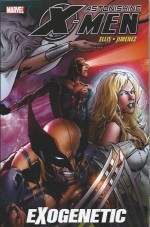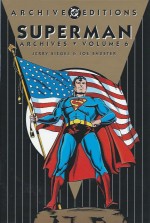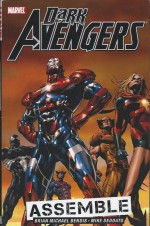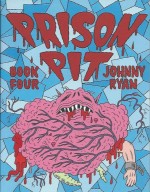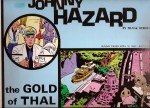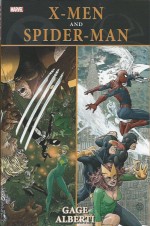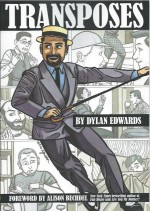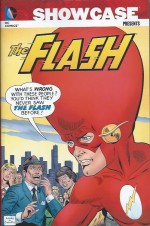
By John Broome, Gardner Fox, Frank Robbins, Carmine Infantino, Ross Andru & various (DC Comics)
ISBN: 978-1-4012-2297-0
Barry Allen was the second speedster to carry the name of Flash, and his debut was the Big Bang which finally triggered the Silver Age of comics after a series of abortive original attempts such as Captain Flash, The Avenger, Strongman (in 1954-1955) and remnant revivals (Stuntman in 1954 and Marvel’s “Big Threeâ€, Human Torch, Sub-Mariner & Captain America from 1953 to 1955).
Although none of those – or other less high-profile efforts – had restored the failed fortunes of masked mystery-men, they had presumably piqued readers’ consciousness, even at conservative National/DC. Thus the revived human rocket wasn’t quite the innovation he seemed: alien crusader Martian Manhunter had already cracked open the company floodgates with his low-key launch in Detective Comics #225, November 1955.
However in terms of creative quality, originality and sheer story style The Flash was an irresistible spark and after his landmark first appearance in Showcase #4 (October 1956) the series – eventually – became a benchmark by which every successive launch or reboot across the industry was measured.
Police Scientist – we’d call him a CSI today – Barry Allen was transformed by an accidental lightning strike and chemical bath into a human thunderbolt of unparalleled velocity and ingenuity. Yet with characteristic indolence the new Fastest Man Alive took three more try-out issues and almost as many years to win his own title. However when he finally stood on his own wing-tipped feet in The Flash #105 (February-March 1959), he never looked back…
The comics business back then was a faddy, slavishly trend-beset affair, however, and following a manic boom for superhero tales prompted by the Batman TV show the fickle global consciousness moved on to a fixation with of supernatural themes and merely mortal tales, triggering a huge revival of spooky films, shows, books and periodicals. With horror on the rise again, many superhero titles faced cancellation and even the most revered and popular were threatened. It was time to adapt or die…
At the time this fourth collection of his own hard-won title begins, the Vizier of Velocity was still an undisputed icon of the apparently unstoppable Superhero meme and mighty pillar of the costumed establishment, but dark days and changing fashions were about to threaten his long run at the top…
Reprinting the transitional issues #162-184 (from June 1966 to December 1968), this compilation shows how Flash had set into a comfortable pattern of two short tales per issue leavened with semi-regular book-length thrillers; always written by regular scripters John Broome or Gardner F. Fox and illustrated by Carmine Infantino (and Joe Giella) but that safe format was about to radically change.
Flash #162 featured the Fox-penned sci-fi chiller ‘Who Haunts the Corridor of Chills?’ in which an apparently haunted fairground attraction opened the doors into an invasion-mystery millions of years old and stretched the Scarlet Speedster’s powers and imagination to the limit, whilst the next issue offered two tales by globe-trotting author Broome.
‘The Flash Stakes his Life – On – You!’ took an old philosophical adage to its illogical but highly entertaining extreme when criminal scientist Ben Haddon used his gadgets to make the residents of Central City forget their champion ever existed. That then had the incredible effect of making the Flash fade away and, were it not for the utter devotion of one hero-worshipping little girl…
By contrast ‘The Day Magic Exposed Flash’s Secret Identity!’ is a sharp duel with a dastardly villain as approbation-hungry evil illusionist Abra Kadabra escaped prison and traded bodies with the 64th century cop sent to bring back to face future justice, leaving the Speedster with an impossible choice to make.
Issue #164 held another pair of fast fables. ‘Flash – Vandal of Central City!’ by Broome, found the hero losing control of his speed and destroying property every time he ran. Little did he know old enemy Pied Piper was back in town… Kid Flash then solo-starred in the Fox tale ‘The Boy Who Lost Touch with the World!’ as Wally West’s nerdy new friend suddenly became periodically, uncontrollably intangible…
With Flash #165 and ‘One Bridegroom too Many!’ Broome, Infantino & Giella took a huge step in the character’s development as Barry finally married his long-time fiancée Iris West. This shocking saga saw the hero’s sinister antithesis Professor Zoom, the Reverse-Flash attempt to replace him at the altar in a fast-paced, utterly beguiling yarn which also posed a Gordian puzzle for Barry.
Should the nervous newlywed reveal his secret identity to Iris – who had no idea she was marrying a superhero – or say nothing, maintaining the biggest lie between them and pray she never, ever found out? Every married man already knows the answer* but for us secretive little kids reading this the first time around, that question was an impossible, imponderable quandary…
Building soap opera tension by fudging the issue, #166 carried on as usual with Broome’s delicious comedy ‘The Last Stand of the Three-Time Losers!’ which saw a cheesy bunch of no-hoper thieves accidentally discover an improbable, exploitable weakness in Flash’s powers and psyche, after which the Monarch of Motion became a ‘Tempting Target of the Temperature Twins!’ when Flash sprained his ankle just as Heat Wave and Captain Cold chose to renew their almost-friendly rivalry in Central City…
With #167 Sid Greene became the series’ inker and kicked off his run with a light-hearted but accidentally controversial Fox/Infantino tale that utterly incensed the devoted readership. ‘The Real Origin of The Flash!’ introduced Heavenly Helpmate – and Woody Allen look-alike – Mopee who had long ago been ordered to create the accident which transformed a deserving human into the Fastest Man Alive.
Tragically, Mopee had cocked-up and was now back on Earth to rectify his mistake and it took all of Flash’s skill, ingenuity – and patience – to regain his powers. The story is a delightfully offbeat hoot but continuity-conscious fans have dubbed it apocryphal and heretical ever since…
Less contentious was Fox’s back-up yarn ‘The Hypnotic Super-Speedster!’ which allowed Kid Flash an opportunity to bust up a gang of thieves, prank a theatrical mesmerist and give a chubby school chum the athletic thrill of a lifetime.
Broome then produced for #168 a puzzling full-length thriller in which the Guardians of the Universe sought out the Flash and declared ‘One of our Green Lanterns is Missing!’ Even as the Scarlet Speedster hunted for his missing best buddy, he was being constantly distracted by a gang of third-rate petty thugs who had somehow acquired incredible futuristic super weapons…
Flash #169 was an all-reprint 80-Page Giant represented here by its stunning cover and an illuminating ‘How I Draw the Flash’ feature by Carmine Infantino, followed by a full-length Fox thriller in #170. ‘The See-Nothing Spells of Abra Kadabra!’ found the Vizier of Velocity hexed by the cunning conjuror and unable to detect the villain’s actions or presence. Sadly for the sinister spellbinder, Flash had help from his visiting Earth-2 predecessor Jay Garrick and JSA pals Doctors Fate and Mid-Nite…
‘Here Lies The Flash – Dead and Unburied’ (Fox, Infantino & Greene) pitted the restored speedster against Justice League foe Doctor Light, who was attempting to pick off his assembled enemies one at a time whilst #172 offered a brace of Broome blockbusters beginning with ‘Grodd Puts the Squeeze on Flash!’ which saw the super-simian blackmail his nippy nemesis into (briefly) busting him out of a Gorilla City cell, whilst ‘The Machine-Made Robbery!’ featured the return of that most absent-minded Professor Ira West. Luckily son-in-law Barry was around to foil a perfidious plot by cunning criminals. The genius’ new super-computer was public knowledge, and by clever crooks wanted to hire the device, secretly intent on designing a perfect crime.
Issue #173 featured a titanic team-up as Barry, Wally West and Jay Garrick were separately shanghaied to another galaxy as putative prey of alien hunter Golden Man in ‘Doomward Flight of the Flashes!’ However Broome’s stunning script slowly revealed layers of intrigue and the Andromedan super-safari concealed a far more arcane purpose for the three speedy pawns, before the wayward wanderers finally fought free and found their way home again.
In 1967 Infantino was made Art Director and Publisher of National DC and, although he still designed the covers, Flash #174 was his final full-pencilling job. He departed in stunning style with Broome’s ‘Stupendous Triumph of the Six Super-Villains!’ in which Mirror Master Sam Scudder discovered a fantastic looking-glass world where the Scarlet Speedster was a hardened criminal constantly defeated by a disgusting do-gooder reflecting champion.
Stealing the heroic Mirror Master’s secret super-weapon Scudder called in fellow Rogues Pied Piper, Heat Wave, Captain Cold, Captain Boomerang and The Top to enjoy their foe’s final downfall but they were not ready for the last-minute interference of the other, evil, Barry Allen…
When Infantino left, most fans were convinced the Flash was ruined. His replacements were highly controversial and suffered most unfairly in unjust comparisons – and I count myself among their biggest detractors at the time – but in the intervening years I’ve leaned to appreciate the superb quality of their work.
However, back in a comics era with no invasive, pervasive support media, Flash #175 (December 1967) was huge shock for the fans. With absolutely no warning, ‘The Race to the End of the Universe!’ proclaimed E. Nelson Bridwell as author and introduced Wonder Woman art-team Ross Andru & Mike Esposito as illustrators.
Moreover the story was another big departure. DC Editors in the 1960s had generally avoided such questions as which hero is the strongest/fastest/best for fear of upsetting some portion of their tenuous and perhaps temporary fan-base, but as the superhero boom slowed and the upstart Marvel Comics began to make genuine inroads into their market, the notion of a definitive race between the almighty Man of Steel and the “Fastest Man Alive†had become an inevitable, increasingly enticing and sales-worthy proposition.
After a deliberately inconclusive first race around the world – for charity – (‘Superman’s Race with the Flash’, Superman #199, August 1967, reprinted in the themed volume Superman Vs Flash) the stakes were catastrophically raised in the inevitable rematch from Flash #175.
The tale itself found the old friendly rivals compelled to speed across the cosmos when ruthless alien gamblers Rokk and Sorban threatened to eradicate Central City and Metropolis unless the pair categorically settled who was fastest. Bridwell added an ingenious sting in the tale and logically highlighted two classic Flash Rogues, whilst Andru & Esposito delivered a sterling illustration job in this yarn – but once more the actual winning was deliberately fudged.
Broome produced a few more stories before moving on and #176 offered two of his best. ‘Death Stalks the Flash!’ tapped into the upsurge in spooky shenanigans when Iris contracted a deadly fever and her hyper-fast hubby ran right into her dreams to destroy the nightmarish Grim Reaper after which ‘Professor West – Lost Strayed or Stolen?’ delightfully inverts all the old absent-minded gags. Barry’s Father-in-Law successfully underwent a memory-enhancing process but still managed to get inadvertently involved with murderous felons…
Fox then produced one of the daftest yet most memorable of Flash thrillers in #177 as The Trickster invented a brain-enlarging ray and turned his arch-foe into ‘The Swell-Headed Super-Hero!’ after which #178’s cover follows – being merely another all-reprint 80-Page Giant…
Written by newcomer Cary Bates and Gardner Fox, Flash #179 (May 1968) was another landmark. The prologue ‘Test your Flash I.Q.’ and main event ‘The Flash – Fact of Fiction?’ took the multiple Earths concept to its logical conclusion by trapping the Monarch of Motion in “our†Reality, where the Sultan of Speed was just a comic-book character! Offering a simultaneous alien monster mystery this rollercoaster riot was a superb introduction for Bates who eventually became the regular writer of the series and the longest serving creator of the legend of Barry Allen.
First though, jobbing cartoonist Frank Robbins added Flash to his credits by scripting an almost painfully tongue-in-cheek oriental spoof accessing everything from Kurosawa to You Only Live Twice to his own Johnny Hazard strip (see Johnny Hazard: Mammoth Marches On).
In #180 Barry and Iris visited friends in Japan and became embroiled in a deadly scheme by fugitive war criminal Baron Katana to turn the clock back and restore feudal control over Nippon using ‘The Flying Samurai’ – a sinister plot unravelled after only the most strenuous efforts of the newlyweds in an all-action conclusion ‘The Attack of the Samuroids!’
Broome’s last hurrahs came in #182 with the clever return of Abra Kadabra whose futuristic legerdemain and envy of real stage magicians compelled him to turn the speedster into ‘The Thief Who Stole all the Money in Central City!’ whilst ‘The Flash’s Super-Speed Phobia!’ saw an unlikely accident inflict a devastating if temporary psychological disability on the fleet thief-taker.
The tone of the stories was changing. Aliens and super science took a back-seat to less fantastic human-scaled dramas, and Robbins scripted the last two tales in this tome beginning with a devilishly deceptive case of bluff and double-bluff as Barry Allen became ‘The Flash’s Dead Ringer!’ in a convoluted attempt to convince crime-boss the Frog that the police scientist wasn’t also the Fastest Man Alive, before proving that he too was adept at high concept fabulism in #184 when a freak time-travel accident trapped Flash millennia in the future after accidentally becoming the apparent ‘Executioner of Central City!’
These tales first appeared at a time when superhero comics almost disappeared for the second time in a generation, and perfectly show the Scarlet Speedster’s ability to adapt to changing fashions in ways many of his four-colour contemporaries simply could not. Crucial as they are to the development of modern comics, however, it is the fact that they are brilliant, awe-inspiring, beautifully realised thrillers which can still amuse, amaze and enthral both new readers and old lags. This lovely compendium is another must-read item for anybody in love with the world of graphic narrative.
© 1966, 1967, 1968, 2012 DC Comics. All Rights Reserved.
* In case you’re not married, or not a man, the answer is: Fake your own death and move to Bolivia. And if you find a woman there, always tell her everything before she asks or finds out.


